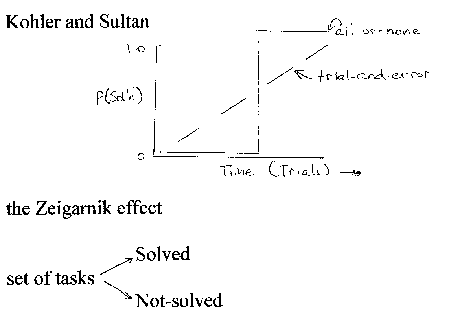Convergent thinking:

how are the following alike: blue rat moon
1. ill and well-defined problems
2. Two historical traditions
-association and search
-Gestalt theory and representation
3. Newell and Simon
-algorithms and heuristics
-problem space
-types of searches
-protocol analysis
4. expertise and creativity
Answer not directly accessible from memory;
thinking involved
Thinking:
Convergent thinking:

how are the following alike: blue rat moon
Divergent thinking

1. Well defined problems
-the initial and goal states are not ambiguous; the mental operators
that you can use to find the goal state is known; you can check the answer
for best-fit
example 1; what should be my next move in a chess game
| example: | DONALD
+GERALD ROBERT |
D=5 |
example:
should I take a job where I worked last year or take a potentially
more exciting job with better long-term potential that pays much less/
1. Problem solving is a problem is search (finding the answer)
-the solution is available in your knowledge base; you just have to find it
example: Thorndike and the "Puzzle Box"
-we often fail to solve problems because we are using REPRODUCTIVE search strategies; that is, trying to solve a problem using strategies that have worked in the past but are not effective with the problem at hand
example of reproductive search failures:
-SET (situational)
-FUNCTIONAL FIXIDNESS (more permanent characteristic of memory)
-the candle problem
the Gestalt tradition: we fail to solve problems because we are representing the problem incorrectly
Gestalt theory
-based on perception
-learning is all-or-none
-principles like figure-ground
example; Kekule and the discovery of the Benzene ring
| . | . | . |
| . | . | . |
| . | . | . |
TASK: using only 4 straight lines, and drawing continuously (can't lift
pen from paper) cover all 9 dots
